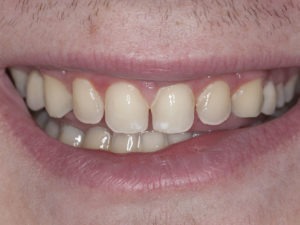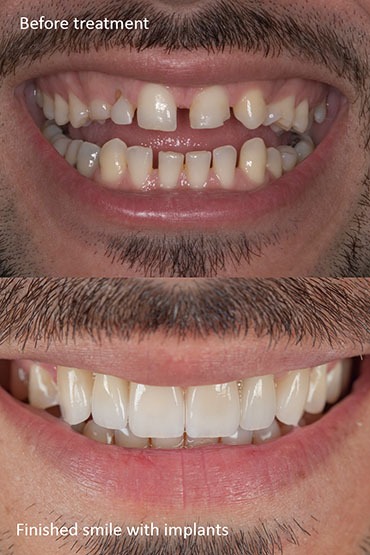
Can my dentist close the diastema between my teeth without braces? Spaces between teeth, sometimes called diastemas are larger than usual spaces between two teeth (also known as gapped teeth). Though these gaps pose no threat to your oral health, it’s appearance can hurt your confidence in your smile. Because it’s technically an arrangement issue, many patients fear that closing the gap means orthodontic treatment, like braces. For many patients seeking treatment, closing a diastema can be very simple. A quick, one appointment bonded filling or a conservative veneer, can fix a gapped tooth quickly.
What causes gapped teeth?
- Abnormal sizes and shapes of teeth
- Chips or fractured teeth
- Tooth loss
- Labial frenum attachment between the upper front teeth
- Thumb sucking
- Tongue thrust
- Impacted or missing adult teeth
- Damage to the jaw bone when the teeth are developing or from gum disease

Before and after image of life-like crowns done to close spaces or diastemas between teeth. After invisalign treatment, implants, and veneers, this patient got a beautiful smile.
Cosmetic bonding can close a diastema
Diastemas are often caused when the size or shapes of teeth are uneven or abnormal. An unusually small tooth will create a space that’s uneven to those around it. Adding to the tooth size to fix gapped teeth may be accomplished with tooth colored composite resins. Your dentist customizes to match your healthy tooth structure and then bonds permanently to the tooth. Tooth bonding builds up the tooth shape so that it fits more uniformly with the rest of your smile. There are multiple benefits to using composite veneers to close a diastema.
Dental bonding:
- Is reversible
- Conserves enamel
- Yields natural looking results
- Is relatively affordable
- Preserves natural tooth structure
Cosmetic bonding can be placed in well under 30 minutes at our office. It is an excellent option to close diastemas between teeth. Dentists begin by cleaning and preparing the enamel surface to receive the bonding material. They will then hand blend the composite resin to ensure that it perfectly matches the color of your natural teeth.
Your dentist will artfully shape the composite resin to close the diastema. The resin is molded to span the gap in your smile. The final step involves making final adjustments and polishing the surface of the tooth. There is no recovery time associated with cosmetic tooth bonding, and very few patients ever report side effects.
Porcelain Veneers may be the best way to fix gapped teeth
Many patients wonder what are veneers? A veneer is a thin wafer of lifelike dental porcelain. Your dentist designs it to closely match the size, shape, color, and overall appearance of your tooth. For many patients with gapped teeth, veneers can be created to fill the diastemas. Porcelain offer more dramatic cosmetic results than cosmetic bonding can. This is one reason why more clients are opting for veneers to brighten their smiles. Ultra thin veneers with little or no drilling have become the most desired option.
Dental veneers are placed through two visits to our office. During your first visit, a small amount of enamel will be removed. This will make room for the veneer to sit flush against the surface of your tooth. Temporary veneers are placed while you wait for your final shells to be placed at a second visit. Following the placement of your new veneers, some patients experience heightened sensitivity, especially to cold and hot foods and liquids. These minor side effects typically subside within a few days.
Porcelain dental crown to close a gap
Sometimes, a tooth is significantly smaller than those around it. Or it has suffered damage to its structure that leaves a space between it and a neighboring tooth. To close a diastema between teeth, your dentist might recommend placing one or two custom designed caps. Lifelike crowns can be fashioned to blend with your smile and to ensure that it closes the diastema.
Once your teeth crown has been manufactured, your cosmetic dentist will place the cap using a strong bonding agent. Most cosmetic dentists offer a wide range of dental crown material options. A well made crown will not be obvious to the eye.
Should I try a DIY fix a gap treatment at home?
The growing trend of DIY or mail order braces to address diastema is of concern to all professional dentists. These unproven products promise to correct gaps in your smile. Some products advise using an elastic band to pull teeth. Doing so can pose serious dangers to your teeth and gums. Remember, any treatment that alters the appearance or orientation of your teeth requires professional supervision. Patients who try to close spaces between their teeth by treating themselves risk damaging or even losing a tooth.
The American Dental Association offers this warning:
The ADA strongly discourages the practice of do it yourself orthodontics because of the potential for harm to patients. Patients are being inundated with direct marketing campaigns encouraging them to initiate and manage their own orthodontic treatment. These campaigns are operating in multiple media outlets, including online, billboards and television ads. [The ADA] supports the importance of dentists being in charge of diagnosing and treating patients to ensure the safe delivery of appropriate care.
Customized dental treatment options to close the diastema between your teeth
While a handful of celebrities can rock a diastema, few of us can. If you have gapped teeth or any other smile concerns, we can offer a number of custom cosmetic solutions. If you are looking for invisible restorations, schedule a consultation by calling us at 847-234-0517. We also proudly serve residents of Chicago and all surrounding communities in the Chicago Metro area.
Dr Fondriest is a Nationally recognized and highly sought after cosmetic dentist. He serves clients from throughout the United States
